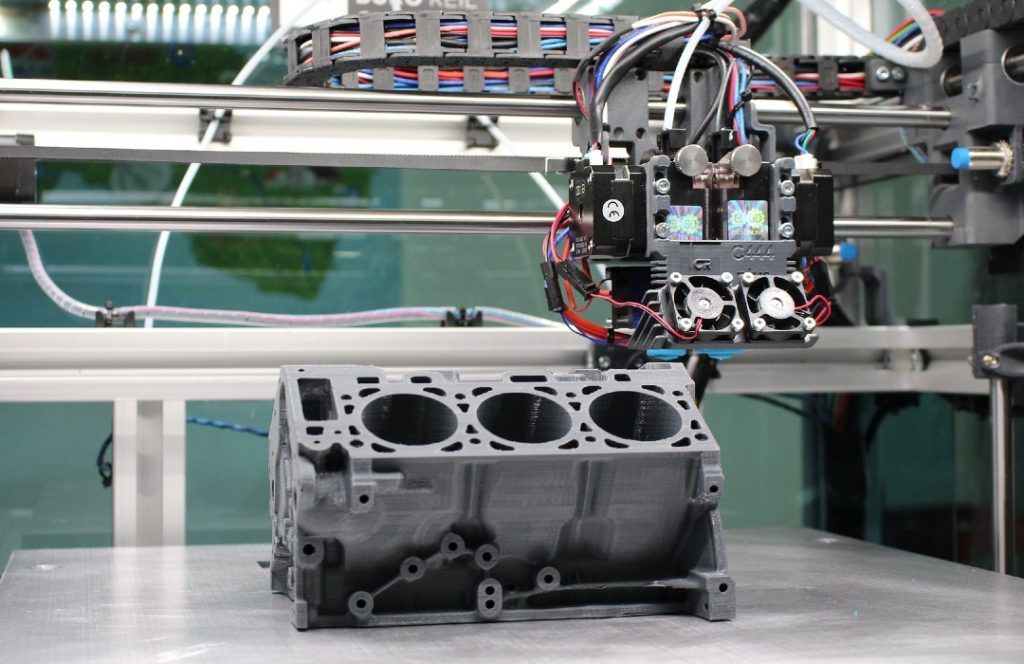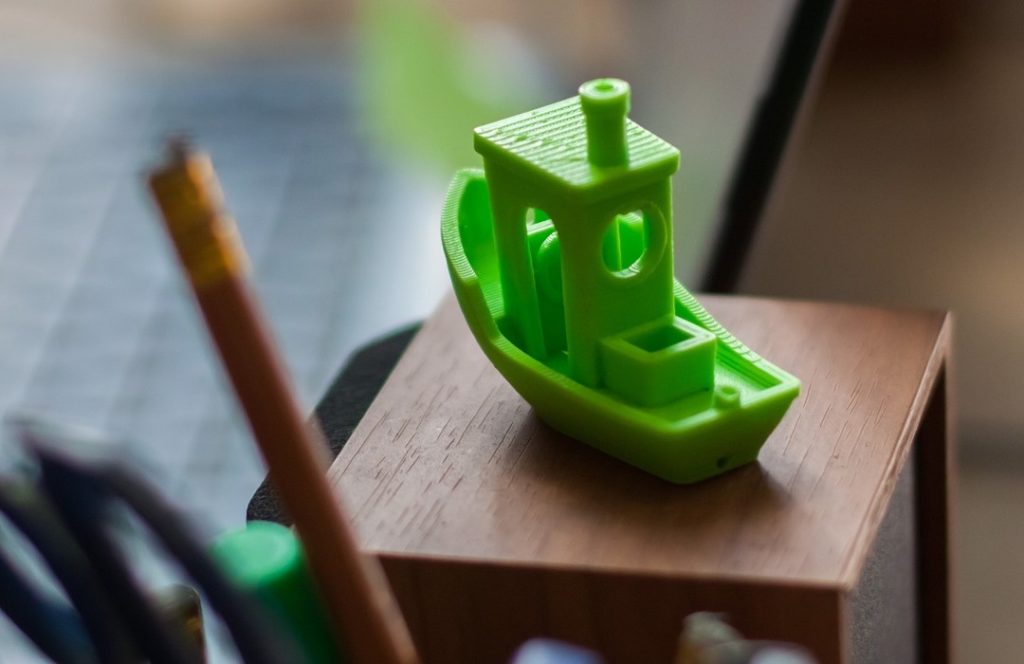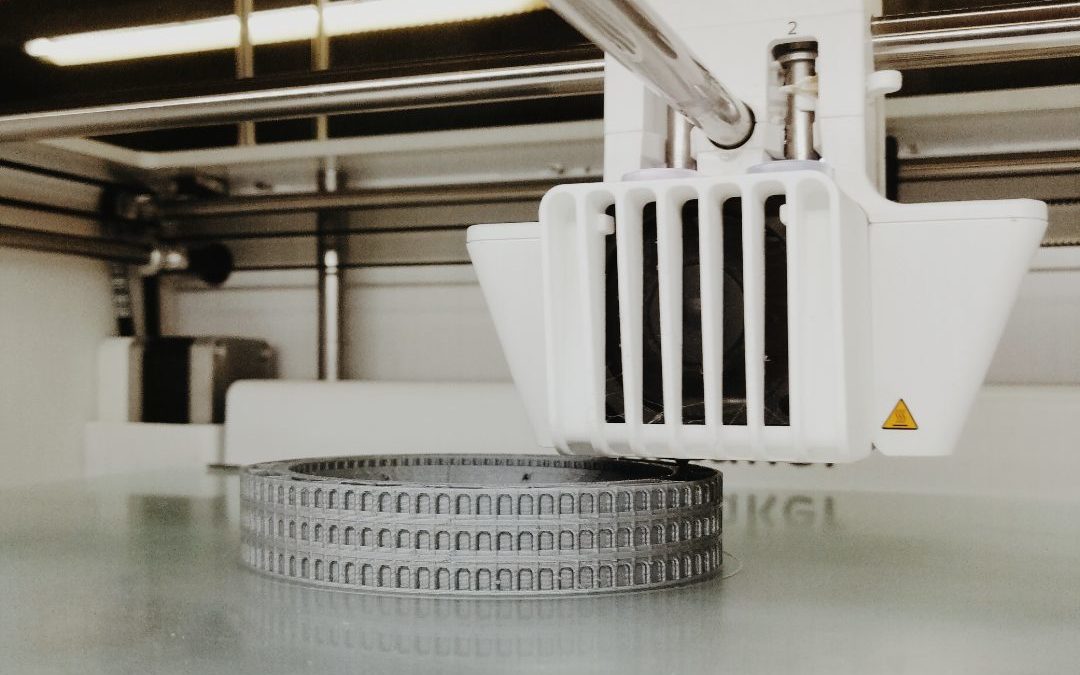1. 3D Printing Is Too Expensive to be Useful Beyond Limited Runs
There are a variety of factors that can affect the cost of 3D printing. However, you may be surprised to learn that 3D printing can be a cost effective solution in many cases. Let’s take a look at some of the factors you should consider to determine if 3D printing is right for your product.
How Complex Is Your Part?
The cost to make a part depends on the complexity of the part. 3D printing is a great option if you need to make geometries that can’t be manufactured conventionally without the use of tooling. If there is a lot of surface detail or contour, or more than a handful of features that need to be machined, then 3D printing can be very cost effective.
Parts with lattice or honeycomb structures, complex curves and angles, or sections that are hollow are good candidates for 3D printing. Less likely to be cost effective are parts that are big and blocky.
For example, to produce an AirPod conventionally, you’d most likely need six to seven different injection-molded tools for the shell and casing. With 3D printing, you can print all of those components without investing in any tooling, and you can even make a custom fit for a specific person’s ear canal if you wanted. 3D printing is an affordable solution for parts that need to be customized to fit people’s specific needs.
How Much Time/Material Does Your Part Require?
You’ll also want to consider the amount of material used, the amount of machine time it takes to make the part, and the amount of engineering complexity involved to produce your part. Your product may be a good candidate for 3D printing if it has a high surface area and/or low production volume. Patient-specific products, such as dental retainers, are widely created with 3D printing.
How Much Inventory Do You Need?
Additionally, the spare parts market for appliances has proven to be a good use of additive manufacturing and 3D printing. This relieves the cost of excess inventory by cutting storage capacity; instead, parts can be manufactured as needed. This shows the possibilities of 3D printing as a supply chain management and cost-cutting technology as well.
Request a Quote
The best way to determine if 3D printing is cost effective for your part is by consulting experts like our team at 3D Printed Parts. By uploading your CAD file, we can easily quote the cost for your specific part.
2. 3D Printing Can Make Anything
Although many shapes are capable of being 3D printed, that doesn’t mean they should be. 3D printing isn’t a one-size-fits-all solution, unfortunately. We can technically print a solid steel block on a metal printer, but if we’re being honest, it shouldn’t be made that way.
3D printing is an additive process. That means it builds a part up particle by particle or layer by layer. Simple geometries that have raw material close to the desired part shape shouldn’t be reduced and additively constructed again.
For example, we get inquiries for fairly niche and limited quantity parts or structures, such as 3D printed houses or antique car dashboard replications. These kinds of jobs can technically be done, but they are not economically feasible, at least not at this point. At 3D Printed Parts, we want to push the envelope when it comes to what can be printed, but we also want to guide you to the best economic and design decisions as well.

3. 3D Printed Parts Are All Plastic
Although the earliest forms of 3D printing were indeed only using plastic, metals and other materials have become more popular in the past 20 years. In fact, in 2018, 3D Printed Parts conducted a survey that counted 230 different engineering-grade materials used by 3D printers.
Metals
Nowadays, we can run production in all types of metals, such as:
- Titanium
- Aluminum
- Tool steel
- Stainless steel
- Refractory metals
Technologies
The initial concepts of 3D printing were intended for plastic production. Today, we see other materials used in additive manufacturing. Some 3D printed parts can now include sensors, electronics, carbon fiber, fiberglass, composites, and more.
Food
Many materials are designed for a specific application and are fueled by customer design. Even food has been printed—primarily confectionary items, like custom cake toppers, chocolate, sugars, and more.
Industry Favorites
Nylon is a common material in automotive printing, as well as polyurethane, TPU, stainless steels, and tool steels. Titanium and aluminum are followed closely by Inconcel and flame retardant nylons in the aerospace industry. In general, nylons are a top material for 3D printed parts, and tool steel is very common for 3D printed tooling for injection molding.
4. 3D Printing Is Inexpensive or Simple
Because 3D printing can be so cost effective, some people mistakenly believe that it can be an inexpensive solution for any niche part you may need. However, there are still real cost drivers that may make 3D printing too expensive for certain projects.
For example, if you need a taillight replicated for your 1972 Buick, it’s not as simple as you might expect. Consider the costs for design, engineering, programming, production, and finishing. Often we get contacted by someone with a sketch or idea, but you can’t just scan a drawing, translate the idea into three dimensions, and print it. We need a 3D engineering design file—a CAD file—which takes time and cost to put together. Then, we need to program the printers with the proper printhead speeds, laser speeds, intensity, and more.
Conversely, 3D printing is a great method for big automotive manufacturers who want to prototype and test different taillight designs. However, it’s simply not cost effective for a consumer to order just one part.
5. 3D Printing Is a New Technology
It’s true that 3D printing is a relatively new technology, but did you know it has been around for more than 30 years? In 1983, Chuck Hull began his innovative engineering efforts to make additive, layered plastic parts. He prototyped the first 3D printer in his basement—today, it resides in the Smithsonian. He made the first 3D printed plastic part with it, which his wife still has. Even metal 3D printing has been around for more than 20 years.
Does that mean 3D printing is a threat to traditional manufacturing? Not exactly. 3D printing is a threat to inefficient manufacturing, but there will always be a need for conventional methods. For low complexity tasks, 3D printing will start to replace traditional manufacturing, and for products that demand extremely high effectiveness or efficiency, 3D printing can start to become a replacement technology.
A new product made with conventional manufacturing will still need an initial design and prototype before you can start selling it. Generally, tooling is developed between the design and prototype phases.
Commercialization for plastic parts can require eight to 20 weeks for tooling to be completed and the first part to come out. It is a very capital-intensive project. 3D printing allows those first launch products to come out of the operations budget, not the capital budget, since you’re not creating a collection of tooling. It also allows you to rapidly iterate product changes, especially compared to stacked tooling cycles.
6. 3D Printing Is Only Good for Low-Volume Jobs
It really depends on the part. If you need to make 500,000 wireless mics, conventional manufacturing is probably the most cost-effective option. If you need iterations or customizations, then 3D printing is a viable option.
We’re starting to see more parts designed with additive manufacturing in mind. Interior components for airplanes have been intentionally designed to be 3D printed to take advantage of a lightweight design. When 3D printing can open up new design capabilities and efficiencies such as this, it is still a viable option for high-volume products.
There are different costs for different production processes. The break-even point varies with competitive technology. For example, let’s say you’re making a computer mouse case. If you need 20–300 plastic cases, 3D printing would be cost effective. More than that, however, and it’s more viable to use injection molding. If there was uncertainty about the design, it could be more effective to go up to 1,000 or more copies to prototype.
Parts with a high surface area over volume ratio can be made effectively at scale as well. You can 3D print up to 1,000 metal parts before casting becomes a more viable option. Also, with patient-specific products like dental implants, hearing aids, orthodontic appliances, as more, 3D printing is likely to become the replacement technology soon.

7. 3D Printed Parts Have to Be Very Small
Not so! The largest plastic parts we make are five feet long, three feet wide, and two feet tall. Some machines can make much longer parts—hypothetically unlimited as a continual part—as they do their printing horizontally.
Every year, more designs and technologies are coming out to enable larger and larger products. In large build platforms, parts can be split into a few pieces and engineered together after printing. Metal printers can go up to 20x20x20 inches, which is rather large for cast metal components.
8. All 3D Printers Work the Same Way
Actually, there are eight core 3D printing technologies:
- Fused Deposition Modeling (FDM): Also known as fused filament fabrication, FDM uses a thermoplastic filament which is extruded through a heated nozzle. The nozzle is mounted on a gantry system, allowing the extruder head to trace the profile of a part on both the x-axis and the y-axis. Think of a glue gun, and you’ll have a decent idea of how the extruder works. This process is repeated layer by layer to complete the part.
- Binder Jetting: Binder jetting is a method of 3D printing in which a raw material, typically in powder form, is spread across a build plate. A print head passes over, similar to an inkjet printer but depositing a binding agent rather than ink. The binding agent is ejected only where it is needed for the product, just as ink is placed only where letters or images are needed when printing on paper. After one layer is printed and the binding agent is placed, a new layer of raw material is placed and the process is repeated until the design is completed, stacking layer on layer.
- Material Jetting or Multi-Jet Printing: Material jetting, also known as multi-jet printing or poly-jet printing, is similar to how a high-speed printhead deposits ink. However, these printers deposit a UV-cured photo acylate instead. This is a liquid plastic resin that gets jetted out of thousands of incredibly small ports called piezos. Piezos are electronically activated to jet microscopic droplets of the molten plastic material onto a build plate. It scans back and forth extremely rapidly, curing the deposited liquid plastic into a solid.
- Selective Laser Sintering (SLS) or Powder Bed Fusion: SLS uses a powder bed on which the powder is selectively fused together layer by layer using a laser. These are generally powdered nylons.
- Direct Metal Laser Melting (DMLM) or Powder Bed Fusions of Metal: With DMLM, metal powders are fused with similar technology to SLS but with a 1000W laser compared to a 300W. Instead of sintering, it fuses, with a result similar to welding.
- Directed Energy Deposition: Directed energy deposition uses a high-power energy source, such as a laser, directed at a melt pool. The feedstock, typically wire or powdered metal, is placed directly into the melt pool of the laser, which fuses the particles or wires together, creating a solid object.
- Stereolithography (SLA) or Vat Polymerization: In SLA, there is a vat of liquid resin in which the build plate is submerged. A laser beam is used to cure the photopolymer. It is submerged further and cured repeatedly, until the build is complete.
- Laminated Object Modeling: In laminated object modeling, sheet material (often paper or thin sheet metal) is cut to the part shape and laminated to subsequent layers, building up the finished part.
9. 3D Printers Can Copy Parts Automatically and Print Them
Not exactly. There are a lot of hidden processes in 3D printing. It’s not as easy as scanning and printing a document, for example.
3D scanners allow you to scan a complex object and create a visual representation of it by taking hundreds of thousands of reference points to create a point cloud data image of the object. Next, the data points are put into a surface element tool that creates a surface geometry design that is sent into CAD. Finally, that design is sent to a 3D printer.
Typically, 3D scanners are used for reverse engineering. Think of an office chair from the 80s you would want to recreate—often the design for something like that is a two-dimensional drawing, sometimes even hand drawn. In that case, it is faster to scan the part and reverse engineer it than to translate a 2D drawing into a 3D design or object in CAD.
3D scanners can also be used in healthcare settings. For example, we’ve been able to see 3D data of a broken bone scanned into a CAD file in order to recreate the break on a 3D printer to use as a physical reference model.
10. 3D Printed Parts Are Weak
In the early days of 3D printing, plastics were very weak and would degrade very quickly. Nowadays, thermoplastics and other materials used in 3D printing are created specifically for this process, ensuring their strength and durability. If you consider these materials in the design and engineering phases, you can actually design stronger, more effective parts.
Before, designers were using 3D printing to create parts that had been designed for other manufacturing processes. Now, even metal parts that are 3D printed match their traditionally created counterparts in full strength. In fact, they are so reliable that rocket engine metal components are being 3D printed every day. These have to hold up to some of the most rigorous environments and forces possible.
If you understand the limitations of the materials you’re working with, and you design with 3D printing’s unique strengths in mind, your part can be even stronger than conventionally manufactured parts.


Recent Comments